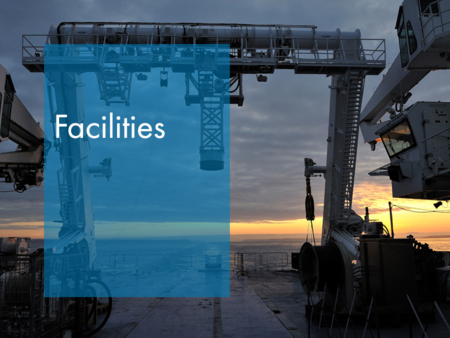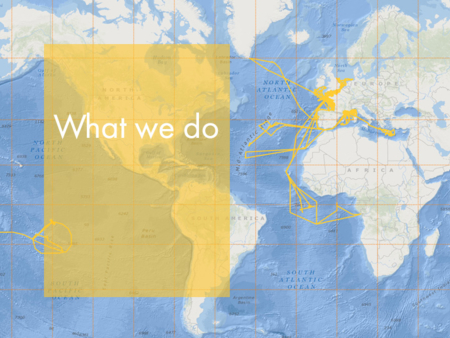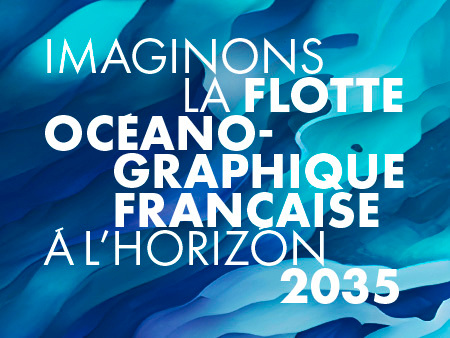1.6. Strengths and difficulties
1.6.1. Points relating to the whole FOF community
Strengths
We might initially mention the great impact of the French community on international programmes, not only due to leading projects but also because of the vast scientific progress it has made and developed in high-impact publications (Science, Nature, Nature Géosciences, PNAS, etc. see complete bibliography report in Appendix 6). These results reveal the research topics that feature among the leading themes for different international programmes and key questions identified today in national and international contexts. A few outstanding points:
- The total number of researchers and technical personnel, including PhD students and anyone who is directly (on the vessels) or indirectly (tests on land, modelling) involved in FOF activities is around 3600, which makes a very significant community;
- The French community is recognised worldwide as a major partner in certain topics (meso and micro dynamic scale, dynamics of the tropical Atlantic and Pacific, carbon cycle and penetration of anthropic carbon, cycle for trace elements and their isotopes, hydrothermalism and deep chemosynthetic ecosystems, etc.);
- Its scientific production can be found in high-impact journals; there is a considerable effort to communicate with the general public through the campaigns;
- Student and young-researcher training is high quality thanks to teaching access to the fleet’s varied resources (station vessels to ocean-going vessels);
- Because of the teams’ skills, their expertise and high technical ability, R&D is very high quality and leads to unique technological developments through the world (core boring, AUV, etc.);
- Access to the vessels, machines and heavy equipment is open to all scientists, subject to approval of a high-quality scientific dossier;
- The peer review system is highly demanding and guarantees good quality. A posteriori monitoring of the development that gives FOF activities great visibility.
Difficulties
Requesting and actually bringing about a scientific campaign at sea currently involves the following major difficulties:
- The multi-purpose RV Suroit has dropped out of the ocean-going fleet, therefore making annual programming less flexible;
- The question of flexibility for interventions at sea, particularly in the coastal area remains an issue in terms of operation and programming. On this last point, it is essential to maintain N+1 annual programming for coastal vessels and an N+2 schedule for ocean-going vessels. The users also wish to be able to make the most of having ship time “in the water” to run an acquisition campaign at sea just after an exceptional and/or major weather-climatic phenomenon (flood, storm, accidental pollution, etc.); all this to answer scientific questions associated with studies on sediment dynamics or coastal environment ecosystems;
- The long search for financial support before, during and after the campaign, as well as the phase offset between campaign assessments and their funding. The number of points of contact to request funding has multiplied, schedules for calls for bids from funding authorities are not in phase with the fleet and do not consider certain specific aspects of the discipline, particularly the campaign programming calendar, that does not depend on the researcher’s whim. The ANR for example, main source of funding for French research, does not consider campaign projects approved by the National Fleet Commissions and only follows its own assessment procedure, which very often prevents financial support from being granted in accordance with the investment that these campaigns represent (boat time, personnel time, machines and instruments);
- The organisational aspect of the campaign including preparation of the campaign, work authorisations and relations with the foreign country observers (highlighted because this is getting worse over time), the container transport logistics, access and availability of equipment held by organisations and/or labs (DT INSU or Ifremer), constraints linked to marine parks, to earthquakes, to hazardous zones, vessel interoperability issues, feasibility problems (problems with a winch, lift, etc.); the community highlights the growing risk linked to national and international regulations becoming more complex particularly in terms of work permit applications (difficult geopolitical zones like the Mediterranean, authorisation given at the last minute, etc.), transporting equipment (blocking containers before arrival at shore) and hazardous products, problems concerning access to biological samples (APA), etc.
- Implementation of technical aspects before and during the campaign with the need to coordinate activities from the different ITs spread over the labs or within the DTs and the variable working conditions on board from one vessel to another, highlighting the need for better monitoring between preparation on land and work at sea;
- Growing difficulties have been revealed in terms of running heavy operations such as deployment of on-board instruments by scientific teams, for which operational costs can be high (HROV). One welcome change would be to expand technical support (validation of data from the different equipment being implemented) by IT personnel assigned to the heaviest instruments.
- Although it is not in the FOF’s remit, the committee is raising the alarm on the lack of IT personnel in the laboratories for development, maintenance and implementation of on-board equipment and marine instrumentation, as well as for small benthic ecology equipment. Several laboratories also consider that lack of IT personnel compromises their activity in the short term.
Furthermore, alerts have been suggested on functioning and subsequent recommendations:
- Optimisation of the complete data chain, from on-board data acquisition to using it in the labs on land, would make the scientific teams’ work considerably easier (establishing an architecture of data provided at the end of campaign that is independent from on-board software, alongside complete management of software for data acquisition and validation). The wide range of software available including software created by IPEV teams or developed by IFREMER could become a strength, if users are consulted on choices;
- Currently, communication associated with the oceanographic campaigns is isolated and occasional, on the initiative of the mission leaders or scientific teams, linked in with their own administrative supervision. There is no coordinated, organised communication action on a FOF scale. Setting up a real communication service dedicated to the FOF would make it possible to increase visibility and development of the FOF results.
The most specific strengths/weaknesses for each topic are given in detail below.
1.6.2. More specifically in Marine Geosciences
Strengths
- The “Margin action” programme, for which major results are mentioned in 1.2.1, is held up as an example in the international community (such as the NSF) and contributes significantly to implementing the IODP-GOLD/DREAM drilling plan in the western Mediterranean basin;
- Insertion in European networks is good (example of the ACCLIMATE campaign partially funded by an ERC);
- Participation in observation networks has been structured over the last few years, mainly concerning archiving and data availability;
- The subsequent period has witnessed positive changes (rejuvenation, new equipment) Access to these resources, via the UMS FOF national assessment commission has also become easier to see. Changes to the ROV Victor, the HOV Nautile, and the addition of new machinery, such as the H-ROV Ariane (for coastal/margin jobs) and the AUV Coral 6000 will help develop an “intervention 6000” vector with an AUV Coral - ROV Victor/HOV Nautile partnership;
- In terms of long core boring, significant developments have been made over the last few years (e.g. accelerometer to record the core drill behaviour, CINEMA software, core drill instrumentation, etc.) particularly thanks to IFREMER and IPEV working closely together. These developments have helped to significantly improve the quality of the very long cores (CALYPSO) obtained using a “pistoned” core boring system. Therefore, France remains, now more than ever, at the forefront of long marine series sampling.
Difficulties
- It is necessary to bring the two main deep-sea intervention machines, ROV VICTOR and HOV Nautile, up to standard (HOV Nautile is operated down to 6000 m and ROV VICTOR can work at 4500-6000 m);
- The coastal fleet is ageing, particularly the RV Thalia that will soon be 40 years old. Furthermore, several ships left the fleet over the previous years (Gwen Drez in 2014, the Côte d’Aquitaine previously, and never replaced). This fleet is the right size for studies along the coast but is quickly out of its depth further out to sea on the shelf, in terms of action radius, deployment of tools and scientific personnel, particularly for the Channel-Atlantic shore. Campaigns carried out by the Thalia, as far as the edge of the continental shelf, are already problematic.
- Apart from the RV Thalia, the in-shore vessels are not equipped with acoustic scientific equipment (multi-beam sounders, hull ADCP), as is the case for all ocean-going vessels, thereby limiting research programmes on the continental shelf (i.e. geological reconnaissance, the earth-sea interface, surface sediment layers);
- It is currently very difficult (or even impossible) to sample and recover boring cores at least 5 metres long in rough sandy sediment on the coastal platform. Thought should go into defining the most reliable and appropriate system whilst being deployed from a vessel the size of Thalia or Côte de la Manche ;
- Care should be taken to allow interoperability of seismic and core boring systems on ocean-going vessels, particularly guaranteeing the presence of systems on board that classically go along with these tools (IT, cutting benches, measuring benches, etc.)
1.6.3. More specifically in Physics-Biology-Cycles
Strengths
- Strong structuring of the national and international community allowing successful major multidisciplinary, multi-lab projects to be submitted. These publications give major international visibility to these campaigns (particularly several special issues of scientific journals associated with recent campaigns such as KEOPS, VAHINE, DEWEX, OUTPACE, GEOVIDE). Acknowledgement and visibility for the community thanks to French implication in Scientific Committees and management of large international programmes (such as GEOTRACES, SOLAS);
- Many national observation services, structured within Research Infrastructures (IR ILICO, IR EMSO, ARGO), that provide the community with qualified data over a long period.
Difficulties
- The phasing between the programming and the period requested by the project is sometimes difficult, due to strong constraints from the biogeochemical context of the area to be studied, generally with strong seasonable variability:
- Due to the fact that the campaigns are essentially multidisciplinary, participants are often involved in setting up at least 2 projects in parallel: given the complexity of financial set-up tied in with programming ships, this can often lead to problems with the community’s driving forces that would find it hard to get involved in 2 major campaigns (more than 45 days at sea) in the same year;
- Distribution of ship time between labelled observation services and specific research projects runs the risk of going against the latter, particularly due to lack of positions for physicists in observatories and rising pressure for observation needs.
1.6.4. More specifically in Biology-Ecology-Biodiversity
Strengths
- Strong ramp-up of studies on marine biodiversity with the initiator role of the Census of Marine Life in which the French community has been very active, in all compartments: fauna and flora, macro and microbiology;
- An ocean-going fleet that is suitable for multidisciplinary ecology-biogeochemical projects in the pelagic field, biology-geology in the deep-sea area;
- An in-shore coastal and station fleet to support studies on different scales and to make it possible to test new biological data acquisition systems;
- A well-structured network of stations and marine labs (Resomar) bringing together the specialised scientific communities, among others, in the study of pelagic and benthic ecosystems, and observation services on which functional ecology or evolving ecology projects can rely:
- Easy access to biodiversity “hotspots” in overseas territory, that represent very significant biodiversity potential that is still very under-explored, except perhaps, in the Pacific thanks to the presence of an RV based there for over 40 years (Coriolis, then Vauban and now Alis).
Difficulties
- Lack of national structuring of the BEB community in the marine field, this being naturally organised over the biological processes regardless of whether the environment being studied is continental or marine. Some examples are GDR Biological Invasions, Chemical ecology, Environmental genomics, Tropic ecology. Partially compensated at a European level (e.g. EuroMarine, EMBRC);
- Access to distant zones (Pacific, Indian) remains difficult in terms of programming, considering recurring constraints on the fleet that limit the flexibility of open-sea programming (Observation, SHOM);
- A coastal fleet that limits the possibilities of multidisciplinary campaigns: the biological aspects should be coupled with the biogeochemists’ analyses in the water column, or the geologists’ analyses in the benthic area.
1.6.5. More specifically in Fisheries
Strengths
- Four FOF ships that are perfectly suitable to collect fishery data (Thalassa in open-seas, Europe on the coast, Antea in mixed circumstances, plus the Thalia along the coast for “Scallop” campaigns and line trawling in estuary zones);
- Vessels allowing series of campaigns to be run over long periods with stabilised protocols for many years: internationally validated sampling protocols, standardised and reproducible campaigns, funded 80% from 2017 by the European Commission within the framework of the DCMAP (Data collection to help the common fishing policy). This helps produce reliable affluence figures that can be used directly in international work groups to assess stocks, a direct contribution to civil society (contribution to the common fishing policy by defining the TAC and annual quotas, directly applicable to commercial fisheries) and finally, production of data for scientific research.
Difficulties
- Since the RV Gwen Drez left the fleet at the end of 2014, the FOF no longer has a low draught coastal vessel suitable for sampling wide-mouthed nets requirement to sample large mobile species (basket trawling) whilst certain campaigns and research work require sampling of this compartment of ecosystems in the shallow coastal zones (< 20m);
- The perspective of the RV Thalia leaving the fleet, scheduled for the coming years (by 2020 in theory), if it is not replaced, would leave a gap of a coastal vessel that can operate drag nets to sample large benthic invertebrates (such as scallops) and line trawling for flat fish (e.g. sole);
- Within the framework of the common fishing policy (CFP), the European Commission (EC) has contemplated the chance of entrusting recurring campaigns for DC-MAP to Member States based on a call for tenders rather than a mandate given to each Member State depending on its contribution to the quota for species targeted in these campaigns (threshold set at 3%). The cost of days at sea for the main vessel used for French fishery campaigns, namely the RV Thalia, is greater than the cost of vessels from many Member States, which does not make the FOF very competitive compared to other Member States if this type of call for tenders came about;
- Within the context of applying the Marine Strategy Framework Directive (MSFD), the theoretically inevitable idea of extending fishery campaigns to an ecosystemic approach might affect work organisation, currently regulated just on the fishing constraints.
1.6.6. Specific points for Overseas Territories
Strengths
- The overseas territories represent France’s long-term interests and obligations in the regions and in contexts with very different ways of working and features than the mainland. Knowledge issues are nevertheless important because they concern topics that vary as widely as biodiversity or the climate (see section 2.1.6) and require collaboration with scientific communities from other countries in the region. The presence of French scientists is decisive to do this.
- In the Pacific, the French archipelago of New Caledonia, Polynesia and Wallis and Futuna are among the most important in terms of surface area and economic development in Oceania. The patrimonial value of the reef ecosystems that they house is the origin of important marine protected areas. Thanks to the presence of the Alis in Nouméa, and support from a dive team dedicated to studying the reef environment, it has been possible to develop and support partnerships with neighbouring countries through SOUTH-SOUTH and NORTH-SOUTH programmes from French Polynesia to the east as far as Papua New-Guinea, or even Vietnam in the west. (See all the campaigns in Fiji, Salomon, Vanuatu, Papua New Guinea);
- More generally; the presence of multi-purpose, intermediate-size Oceanographic Vessels in tropical zones, the Alis in the Pacific and the Antea in the Indian Ocean (La Réunion, Mayotte, Scattered Islands) and the Atlantic (Guiana and Caribbean) can cover all research run in the tropical overseas territories. Furthermore, these two RV have the specific feature of being able to simultaneously run campaigns that are open-sea (oceanographic, fisheries and geophysics) and coastal (oceanography and geophysics of lagoons). This explains why they are the only FOF RV for which campaigns can be assessed either by the coastal commission or by the open-sea commission of the FOF (CNFC and CNFH).
Difficulties
- The presence of the French oceanographic community, in the form of platforms or permanent teams, nevertheless remains very poor compared to the EEZ surface area, the overseas linear distance (97% EEZ and 68% linear) and their associated scientific issues;
- In the Caribbean, or even in the tropical part of the Indian Ocean, the significant ecological and economic potential represented by the overseas territory is currently under-exploited/valued because no vessel remains constantly in the area. The occasional passing of the FOF boat (Antea or another) fills this gap on an ad-hoc basis. Unfortunately, there is no equivalent of the IPEV, set up to study polar regions, to support the study of tropical regions in overseas territory (in the area run by the TAAFs, the scattered islands are considerably less well known than the sub-Antarctic islands);
- The ageing of the Alis, its small size (28.40m) and, above all, its low capacity for scientists (6 persons) considerably limit its working possibilities. The Alis will be 30 years old in 2017, its ageing leads to increasingly expensive maintenance and affects safety. Its replacement should be envisaged by the early 2020s.
1.6.7. Specific points for on-board teaching
Strengths
- Good insertion in European and international networks (the Marine Universities Network is affiliated with the Marine Board plus agreements with the CONISMA- Italian marine university network, agreements with Brazil and Quebec, beyond agreements between universities or International Master’s training);
- The current format for assessing requests and monitoring give equal access to the FOF vessels.
Difficulties
- Need to make the slots for different types of on-board teaching last longer, and the new FOF organisation should ensure that the teaching mission is renewed on station and coastal vessels, as well as opening up to floating universities or seaside universities on-board coastal and ocean-going vessels. To do this, the flexibility of the programming must be maintained, particularly for ships in the station and in-shore fleet, and the possibility of work on H24 developed for the latter as well as making on-board equipment suitable for the different approaches and measurements involved in the different fields of marine research;
- It is important to keep teaching programming options outside calls for tenders (and sometimes even as and when if annual programming allows this), given current difficulties to make the most of places available for students from different fields of training within existing missions (observation, research, public service). Funding complements to allow students to get on-board the fleet’s vessels are sometimes lacking and should be researched among different authorities;
- It must be ensured that the on-board models are properly displayed in the training models.




